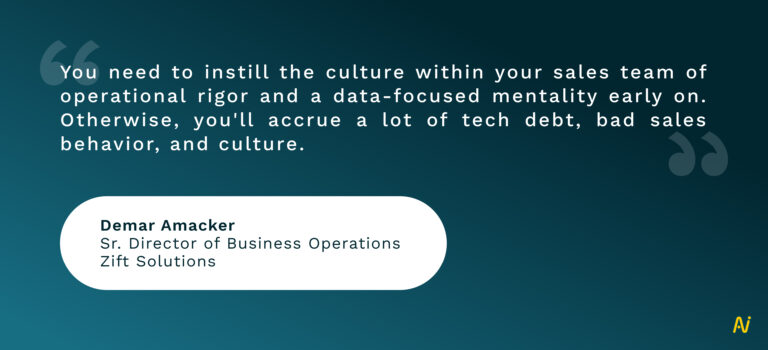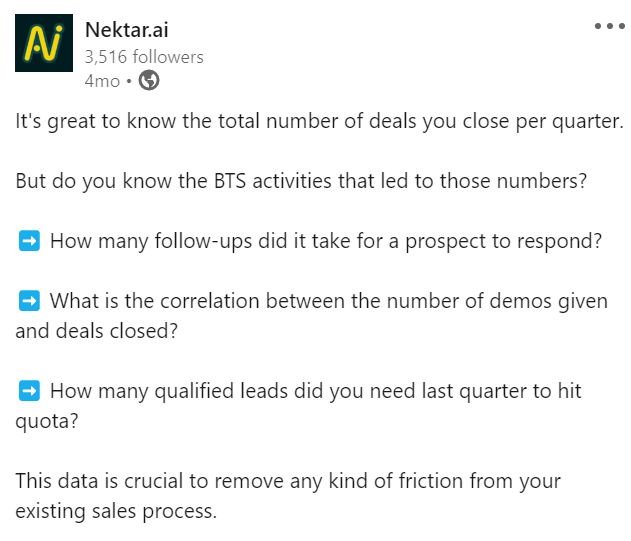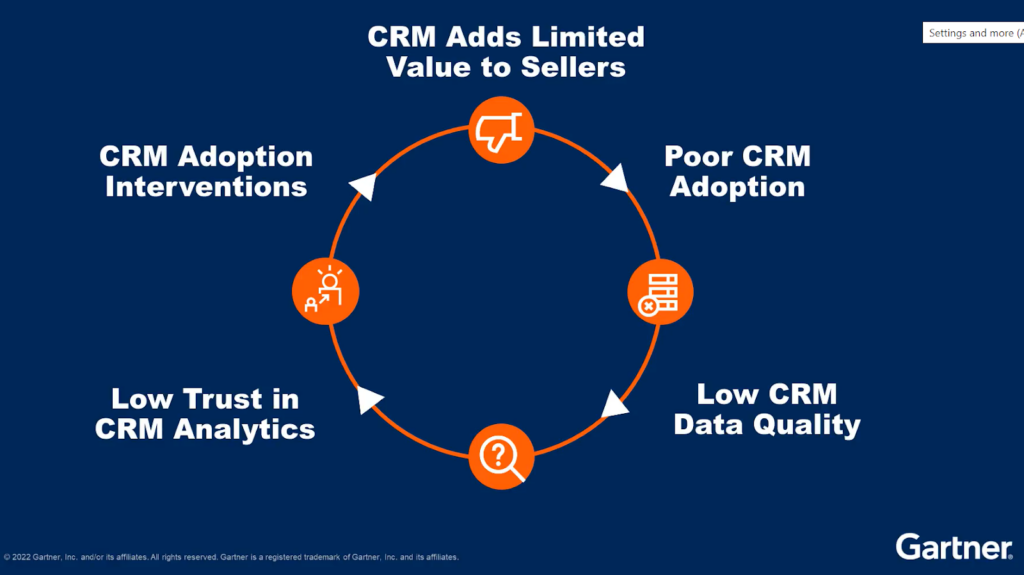
5 CRM Data Challenges that Impact Sales Productivity
Sales productivity taking a hit? Missing and faulty CRM data could be to blame. Read this blog to learn more
- CRM
- RevOps
The ongoing economic uncertainty has slowed down funding to a large extent, prompting revenue leaders to look at business success differently. Cutting down the focus on growth at all costs, they’re now pursuing “productivity at all costs.”
So, where should you double down as a revenue leader to boost rep productivity?
CRM, the central hub of all sales activity, is the best place to start.
CRMs act as data centers for sellers, and those with high-quality data can support highly efficient sales teams.
But CRM data leakage (faulty, poor, incomplete, and unreliable data) can disrupt RevOps, resulting in a significant dip in productivity.
Missing or Inaccurate Data Bears Risks
As much as 79% of the opportunity data collected by reps never steps foot into the CRM.
Even worse, reps may capture dirty data (inaccurate, non-compliant, or outdated) when they enter contact information in the CRM. On the other hand, quality data remains stuck in sales tools, inboxes, calendars, meeting notes, and supporting platforms.
It’s a rising problem as 91% of CRM data is incomplete, stale, or duplicated each year. Adding to the challenge, 70% of this data decays annually.

Business decisions made on insights and analysis gathered from bad data cause more harm than any other errors. Following the concept of “garbage in, garbage out,” poor quality intelligence leads to poor quality decision-making.
This shortcoming ultimately hampers marketing and sales campaigns. Mainly when there’s no layer of intelligence to enrich sales data, sales reps have difficulty closing deals involving multiple stakeholders in the buying committee.
Reps could destabilize multithreading by not having enough accurate information on each participant.
For instance, the IT leader may be more interested in understanding the functional and underlying take makeup of your solution. But reps don’t have enough data to arrive at this insight. Instead, they send a generic document to all stakeholders with extensive marketing and financial information, which may be less relevant to the IT team.
The result – a flawed customer experience.
Let’s see how CRM data leakage affects sales productivity and what you can do to solve the problem.
5 Key CRM Data Challenges Responsible for a Dip in Sales Productivity
While there could be multiple reasons for a dip in sales productivity, we’ll look at five significant problems of CRM data leakage that slow down productivity.
1. Incomplete insights on leading indicators
52% of sales leaders report that their CRM costs potential revenue opportunities because the system doesn’t effectively meet their needs.
To fuel predictable revenue and motivate reps, you need to know everything happening in your business in real time.
Relying on lagging indicators doesn’t help productivity. They’re geared toward past performance and don’t provide information on ongoing deals, such as
- What opportunities are stuck?
- Which reps aren’t hitting their quota attainment and why?
- What are the key channels to communicate with a particular buyer?
Reps need insights into leading indicators (predictive measures of future performance) to close deals successfully and repeat winning tactics. These indicators clearly show buyer-seller activity and where deals are headed.
Some critical leading indicators are
- Buyer vs. sales stage
- Number of sales activities per sales stage
- Number of multithread deals
- Multithreading score
- Productivity score

CRM data leakage blocks actionable intelligence on leading indicators. So, reps don’t know what to make of their CRM data.
Ultimately, this makes effective selling a challenge.
Reps have to look at multiple data points spread across several platforms for critical pieces of information on a prospect. It leaves them clueless about the buyer’s selling stage and affects deal prioritization.
CRM data leakage also inhibits you from using a combination of lagging and leading indicators to close deals better.
Consider this. Leading indicators allow you to see what new opportunities are created and how many first meetings are done in a given period.
From there, you can drill down to see what activities reps undertake to win more deals and how this impacts your pipeline using sales metrics (lagging indicators). Or, if something isn’t right, you can figure out what needs to be done to resolve the problem.
None of this is possible without high-quality leading indicators, adversely impacting reps’ selling abilities and productivity.
2. CRM Data Capture Remains Largely Manual
For 76% of companies, poor adoption of sales tools is a primary reason they miss sales quota attainment.
Moreover, organizations have wasted a considerable amount on sales tools that weren’t fully adopted by reps – an average of $313,000, to be precise.
One of the top causes for reps to dislike CRM is manual entry. And it’s clear why, as reps continue to tackle evolving selling processes to attract the evolved buyer.
On any given day, reps have to get through a series of simultaneous tasks to win deals, like
- Researching prospects, their business size, location, target audience, and more.
- Hosting discovery calls with interested leads.
- Cold calling and emailing new prospects to refresh the sales pipeline
- Nurturing stakeholder relationships within a buyer group to push deals through the sales funnel faster
- Handling internal reviews with peers and managers, exchanging feedback and new selling ideas
Amongst it all, entering data manually into the CRM after each buyer interaction feels extremely tedious and unnecessary. Not to mention time-consuming, too.
When faced with the massive responsibility of entering contact data, reps spend more time on administrative activities than prospecting and selling (i.e., their core responsibilities). The consequences are disastrous, as non-selling activities add up to one full day of work every week for reps!

Reps subsequently prefer putting more time into building buyer engagement. And if they can’t accomplish this feat, they experience a “drag” on productivity.
Unmotivated sellers are a wound in the side for sales quota attainment and winning deals. This pushes them to explore other opportunities outside the organization, carving a dent in your bottom line.
3. CRM Acts as a System of Record as Opposed to a System of Actionable Insight
Sometimes, reps consider the CRM a monitoring tool that tracks their activities.
Managers enforce the use of a CRM to record all contact and account data. They then use this information to stack up evidence against their performance to be used later.
That’s because you may look at the CRM only as a system of record rather than a system of insight. In reality, its resourcefulness goes far beyond criticism and toward simplifying sales processes.
It’s easy to make this mistake when CRM data leakage stops you from using the platform to its best.
CRM data leakage builds suspicion of the platform, owing to a lack of accurate insights for reps and managers. It further snowballs into losing important deals and a critique of selling activities.
Not just that. Unreliable insights also complicate the user experience and selling process.
50% of sellers feel that their workflows are too complicated, not adding any value to the sales process and resulting in productivity challenges.
There are so many complicated activities to finish that 62% of sales reps must put in additional hours after work or over the weekends to complete non-selling tasks.

So, they continue working with conventional software and tools even if you provide them with a better one.
Conventional tools only pile onto the challenges. Reps who operate traditionally can’t keep up with technology upgrades. Therefore, they’re much less prepared for changes in the business environment.
Reps find adjusting to a new digital reality exceptionally difficult and lose selling confidence. This is because a data-driven approach doesn’t filter down to the frontline teams.
4. An Unhealthy Pipeline Blocks High-Margin Opportunities
Data dumping is a huge problem in this data-centric business world. The CRM experiences data dumping when reps flood the system with every possible piece of data they can gather on every lead.
Irrespective of whether the information is clean or accurate, reps ensure that each detail is recorded. Companies see this happening particularly after hosting a meet-up, trade show, or webinar where reps meet multiple prospects simultaneously.
Not every piece of information that sits in a CRM is useful. Instead, it clogs the pipeline with unnecessary data and causes confusion.
What’s more, it’s never close to getting updated or cleaned owing to its large volume. As a result, nearly 70% of revenue leaders are not confident of the accuracy of data in their CRM.
Too much data is a problem. But what about too little?
A fast-changing business environment pushes reps to pursue multiple deals with multiple stakeholders involved in each deal. They may not have enough time to fill in complete contact details. However, they do make it a point to fill out the mandatory (the usual) fields – generally, name, contact number, and designation.
And then, they move on.
It happens so quickly that there’s no way of knowing if the information entering the CRM is helpful for sales.
Reps may feel that they’ve done their bit by updating contact details. At the same time, they could be oblivious that they wasted effort and time on unimportant data.
This unimportant data can easily cost you profitable deals:
- 75% of reps can’t identify the most valuable opportunities in the sales pipeline.
- Poor quality CRM data leads to 56% of sales reps losing existing customers while 51% lose new deals.
- Poor CRM hygiene ultimately robs organizations of nearly $13 million every year.
Let’s look at an example to understand how data dumping and data misses affect the real-world selling process.
During a discovery call, the buyer may have mentioned they’re facing trouble choosing between multiple tools simply because of an overload of information. But none of this data is entered into the CRM.
The rep may not remember this information for too long. A few weeks later, the deal goes south precisely because the rep didn’t heed the buyer’s pain point. Instead, they overloaded the buyer with more “value-driven” content.
An unsatisfactory buyer experience has a substantial negative impact on sales productivity and confidence.
5. No Visibility Into the Health of Deals
Data is the fuel that runs successful deal reviews.
Managers need accurate and clean data to constructively coach reps and drive actionable intelligence across customer touchpoints in the sales funnel.
38% of sellers feel inadequate coaching is a barrier to success at work. Similarly, CRM data leakage restricts managers from effective coaching and limits 27% of reps from attaining their quota.
Continuing from the example in the previous section, effective coaching could have improved the buyer experience.
While the rep didn’t record enough information or forgot about it, the manager also didn’t have the necessary insights into the deal right from the moment it entered the sales pipeline.
If that happens, there’s no way for managers to understand what went wrong and take steps to rectify the situation. And the deal could be gone forever.
You won’t know which ones are stalled when you don’t have real-time intelligence into deal health. And you, indeed, will find it challenging to help reps get these deals unstuck.
This further hinders reps’ abilities to meet their quotas.
Tracking your reps’ activity data using the CRM allows you to sit down with the team, conduct a peer-to-peer review or one-on-one coaching, and exchange feedback on what could have gone better.
Deal reviews that rely on data feel less like an interrogation. Managers and reps don’t play the blame game but engage in a collaborative process.
It also gives managers the chance to improve reps’ selling skills so that they can handle anything that comes their way.
CRM data leakage hinders a clear view of deal health for both reps and managers, creating challenges for sales productivity.
Sales Productivity Is Better When CRM Data Leakage Is Plugged
Organizations need to steer clear of quick-fix solutions to survive the ebbs and flows of the business environment. Instead, it’s best to turn to a model sustainable for both productivity and growth in the long term.
The first place to start? Always the CRM.
A highly efficient sales team depends on a CRM housing high-quality and reliable data.
Complete visibility into prospects drives predictable revenue by boosting rep productivity. And this begins with getting rid of CRM data leakage.

Deploy a Unified Revenue Data Solution to Plug CRM Data Leakage
Nektar’s unified activity data capture solution provides reliable, complete data for clear visibility across the sales pipeline and customer touchpoints – including emails, virtual calls, and even Slack.
Nektar drives strategic RevOps decisions for seamless GTM functioning by mapping productivity to performance through granular contact and activity data. This empowers you to identify winning sales behaviors and coach reps to repeat these patterns.
By doubling down on activity data, the solution sends deal alerts and deal health scores so you can identify profitable opportunities sooner.
What’s more, you can make quick decisions and push stuck deals in the pipeline via real-time deal intelligence.
This feature comes particularly handy when multithreading with multiple stakeholders. Your reps can hold value-driven conversations and nurture relationships with key stakeholders in the buyer group.
They can also build an accurate buying committee map and deliver hyper-personalized campaigns.
With Nektar, you can uncover accurate, reliable, marketable first-party contacts, increasing your win rate by 20%.
Find out more in the video below, or reach out to our team for a free CRM data scan.


